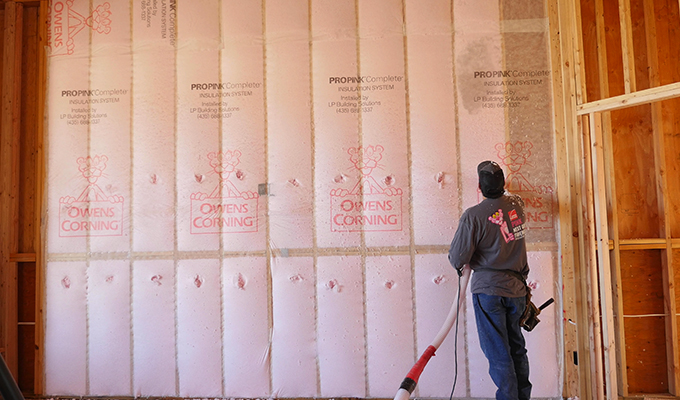In 2008, Dell Pulley and Derek Larsen founded LP Building Solutions, a building products installation firm based in Hurricane, Utah. As an Owens Corning® Certified Energy Expert® (CEE), the firm is recognized as an elite insulation contractor and energy performance consultant.
Trade Experience
With a wealth of combined experience in the trade, Pulley and Larsen have pioneered many insulation and energy efficiency installation techniques, making them ideal collaborators for the CEE’s certification program and giving their workers top-quality training. LP Building Solutions utilizes both blown-in insulation and batt insulation, with blown-in being a more popular high-performance solution for drier climates as well as more humid regions. When working with Owens Corning products, all LP crew members are trained to optimize comfort, noise control, and energy efficiency.
Larsen oversees LP’s daily operations and credits the firm’s success to cutting-edge practices, top-quality materials, and a well-trained staff. An easy camaraderie with family members working side-by-side is evident at the LP facility as crews gather each morning to prepare for the day. Two of LP Building Solutions top crew leaders, Miguel Lizarrage and his son, Miguel, Jr. discuss the benefits of working in the insulation business, especially for minority workers.
Insulation Professionals
“When I came here from Sonora, Mexico, I did various construction jobs,” Miguel, Senior recalls. “My first job was in insulation and then I moved to flooring for a while, but I came back to insulation—I really found my place here at LP—it’s steady honest work that pays well.”
Larsen notes, “We’re lucky to have him, and we appreciate his leadership. Miguel joined us about 5 years ago, but it took a little longer to recruit Junior to the team.”
“Yes,” the younger Lizarrage recalls, “I worked in the oil business for a while, and then I spent some time in the food industry. I had a lot of pre-conceived ideas about insulation installation being itchy and difficult to handle—until my dad straightened me out on the facts.”
With a note of pride in his voice, his father recalls, “In a very short time after being hired, Junior became a leader and was able to manage a crew of his own. I visited one of his jobs and it was top quality.”
Junior acknowledges that working with his dad took some getting used to but was well worth the effort. “We learned how to adapt to each other—you have your actual family who become part of the bigger LP family.”
Training and Instruction
As part of the CEE certification program, the Lizarrages and their coworkers receive regularly scheduled instruction from Owens Corning trainers to ensure that certified workers are installing the materials with solid knowledge and precision. Innovative advances from Owens Corning have resulted in advancements making both blown-in and batt installations faster and easier. The younger Lizarrage talks about the advantages of the training sessions.
“I know for some of the veterans, the classes help reinforce their skills and learn new techniques, but for me, especially when I was first learning, the instruction really helped. They covered different essential techniques and demonstrated skills that I could apply later.”
ProPINK Choice
As crew leaders, both men have seen the advantages of using top quality products on the job. Miguel, Sr. describes the advantages of using ProPINK blown-in fiberglass as compared to an inferior product.
“The superior quality of the ProPINK is really noticeable when blown through the machine, he notes. “With other products, there are chunky clumps that clog up the machine—some have even tried to use cellulose which is not correct. But the PINK is smooth and consistent, and we don’t have to stop for adjustments like we would with other products. This makes the job go faster, so we can be more productive. Our crews never want to work with anything but PINK.”
In its earlier days, blown-in insulation was used primarily in attic spaces, but Owens Corning product innovations have perfected materials and methods, which made it much easier to use on wall studs. In a very competitive industry, the LP Building Solutions team has taken advantage of that technology to steadily increase their market share.
Unlike the free-style, blown-in loose-fill for attics, the wall cavity installation was made much cleaner and efficient with netting fabric. Larsen describes the importance of fine-tuning installation methods to achieve maximum efficiency.
“It’s faster to install because you are not struggling on one wall cavity. You tack the netting to the studs, cut on the “X “and blow the loose-fill fiberglass. Because of the netting, you get a smooth, mar-free appearance while achieving the proper R-Value. Blown walls are growing in popularity for the simplicity and low investment.”
Junior agrees adding, “It’s easier and less mess because the netting catches everything and it looks really good. If we run into the wall cavities not being a uniform size, it doesn’t matter—when you use the ProPINK blown walls method—the consistency is always there.”
Closing Thought
When done properly, blown wall insulation can result in solid profit margins. Such attention to detail is the hallmark of the LP’s winning formula for success in this competitive industry. And, once mastered by contractors like Miguel Senior and Junior, it is a recipe for success and more jobs completed per day and week. “Insulation and learning these new techniques have translated in more opportunities for families like ours,” he notes.
For more about ProPINK blown-in fiberglass, visit www.owenscorning.com.


